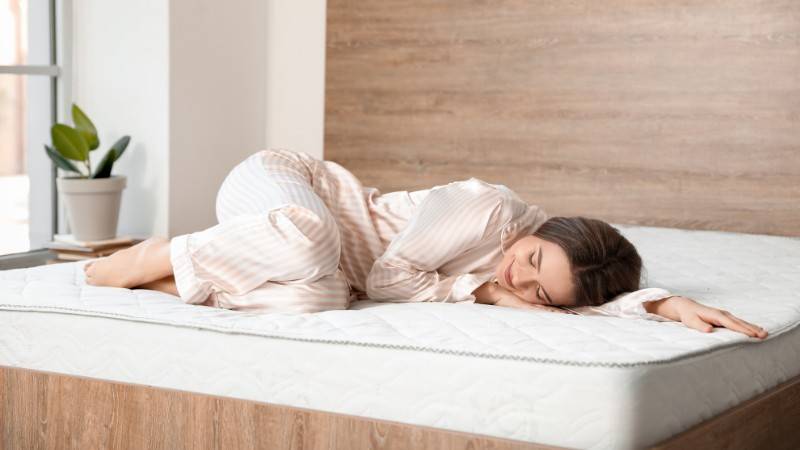If you’ve ever woken up groggy and stiff, your mattress might be doing more harm than good — not just to your body, but to the planet. Conventional mattresses are often made with synthetic foams, flame retardants, and VOC-emitting adhesives that pollute your indoor air and the environment.
That’s where organic mattresses come in.
These sustainable sleep solutions are made from natural latex, organic cotton, and ethically sourced wool — materials that are not only safer for you but also better for the Earth. But here’s the catch: not all “eco” labels mean the same thing, and greenwashing in the mattress industry is very real.
That’s why this guide does two things. First, we’ll take you through some of the most trusted brands in the industry, each vetted for their sustainability ethics and planet-first values. Then, we’ll break down the most important buying considerations — like eco-certifications, material sourcing, and chemical transparency — so you can spot a truly organic mattress.
Whether you’re switching for health reasons or making a conscious lifestyle choice, this blog will help you choose an organic mattress that supports both your spine and your sustainability goals.
7 Organic Mattress Brands You Can Trust
1. PlushBeds: Organic Luxury Crafted for a Cleaner Planet
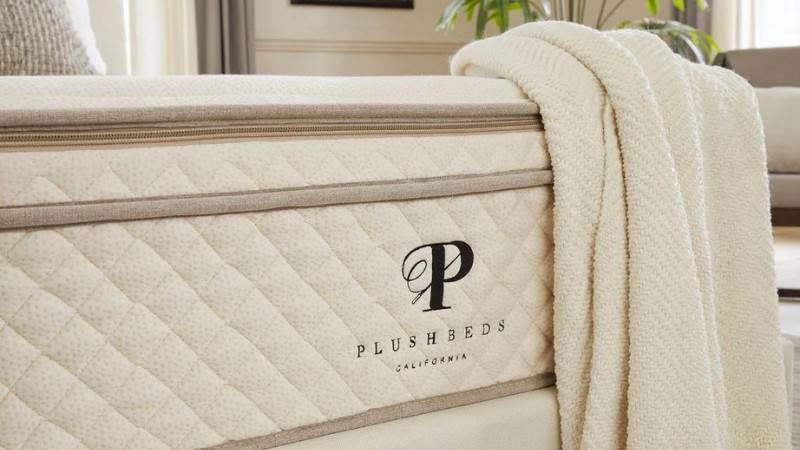
PlushBeds has made a name for itself by blending luxury sleep with eco-conscious innovation. Their commitment to sustainable living runs deep — from sourcing GOLS-certified organic latex to using organic cotton and cruelty-free wool, every material is handpicked with both comfort and the Earth in mind.
Based in California, PlushBeds manufactures its organic mattresses in a GOTS- and GOLS-certified facility, ensuring full control over the ethical sourcing and production process. Their dedication to transparency includes third-party testing and certifications like GREENGUARD Gold, which guarantees low chemical emissions for better indoor air quality.
What truly sets PlushBeds apart is their zero-waste mission and dedication to American craftsmanship. By avoiding offshore outsourcing and focusing on made-to-order production, they reduce overstock waste while supporting local labor and reducing their carbon footprint.
Whether it’s their vegan mattress options or their eco wool that’s ethically harvested, PlushBeds gives sustainably-minded sleepers peace of mind — and body. For anyone looking to invest in non-toxic sleep and responsible consumption, PlushBeds is more than a mattress brand. It’s a sustainability statement in your bedroom.
2. Naturepedic: Setting the Gold Standard for Organic Sleep
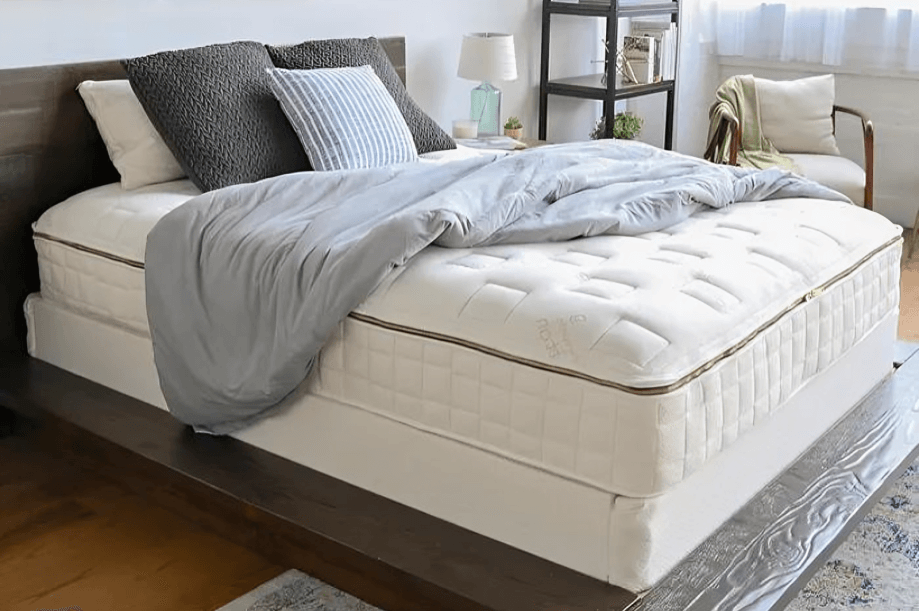
Naturepedic doesn’t just offer organic mattresses — they helped define what that means. As a pioneer in the green bedding movement, Naturepedic builds every product around a single principle: eliminate toxic chemicals from sleep.
Certified by GOTS, GOLS, and MADE SAFE®, Naturepedic uses only organic cotton, organic wool, and organic latex in their mattresses. Their products are crafted in a certified Ohio-based facility, where even adhesives are swapped out for safer, healthier alternatives like heat-sealed glues.
As a family-founded brand led by an environmental engineer, Naturepedic also advocates for stricter labeling laws and chemical transparency in the mattress industry. They’ve even partnered with environmental health organizations to push for safer manufacturing across the board.
With cradle-to-cradle ethics and uncompromising sourcing, Naturepedic is a top choice for those who want an organic mattress that’s as clean for your body as it is for the Earth.
3. Latex For Less: Affordable Sustainability Without Compromise
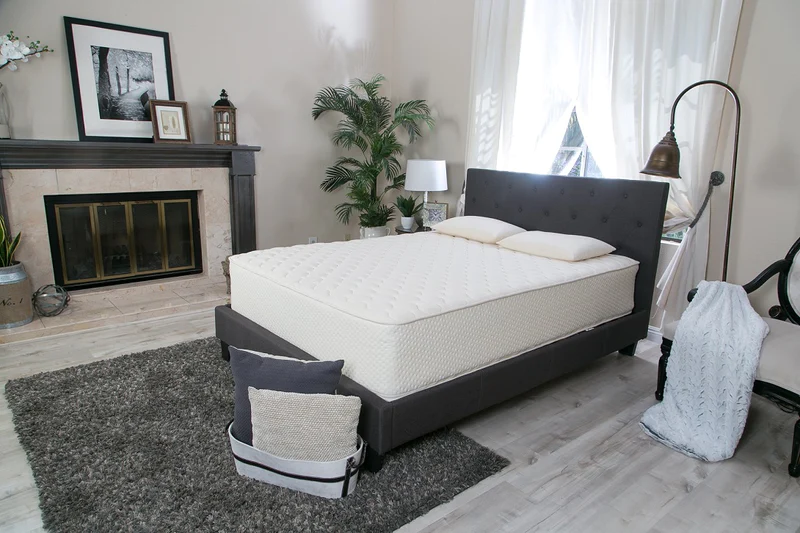
Latex For Less keeps it simple — and sustainable. The brand delivers a no-middleman, direct-to-consumer experience that reduces costs and carbon emissions while offering a 100% natural latex mattress at a lower price point.
Each mattress features organic cotton, pure wool, and dual-sided natural latex — one side firm, one side medium — providing customizable comfort with minimal environmental impact. Unlike synthetic blends, their latex is harvested from rubber trees without fillers or petrochemicals, making it biodegradable and renewable.
Their mattresses are handcrafted in California, minimizing transportation waste and emphasizing localized, ethical manufacturing. Even packaging is designed with a lower carbon footprint in mind.
By making non-toxic sleep more accessible, Latex For Less gives eco-conscious shoppers an affordable entry point into truly sustainable rest.
4. Awara: Rainforest-Fueled Rest with Climate Neutral Commitment
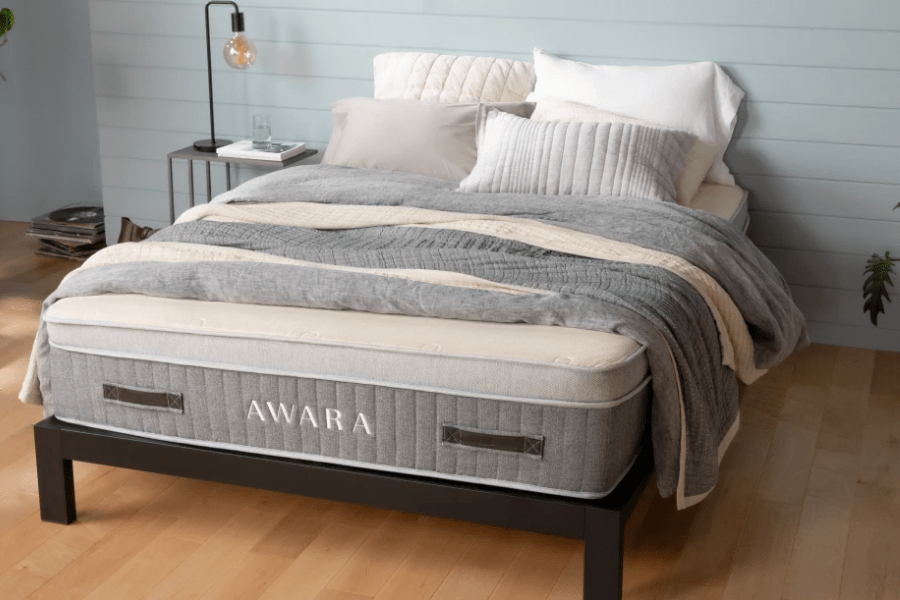
Awara takes a big-picture approach to sustainability. Every organic mattress sold funds the planting of fruit trees in agroforestry projects across Kenya and Central America through their partnership with Trees.org.
Made with GOLS-certified Dunlop latex, organic cotton, and ethically sourced New Zealand wool, Awara’s mattresses combine naturally breathable materials with Climate Neutral-certified operations. They offset all emissions from production to delivery — a rare feat in the mattress industry.
With a hybrid design that merges natural materials and coil support, Awara builds durability into its sustainability promise, reducing landfill-bound waste through longer-lasting products.
If you want your sleep to fight climate change — quite literally — Awara’s forest-positive mission offers a guilt-free, greener tomorrow.
5.My Green Mattress: Family-Run, Planet-Loving
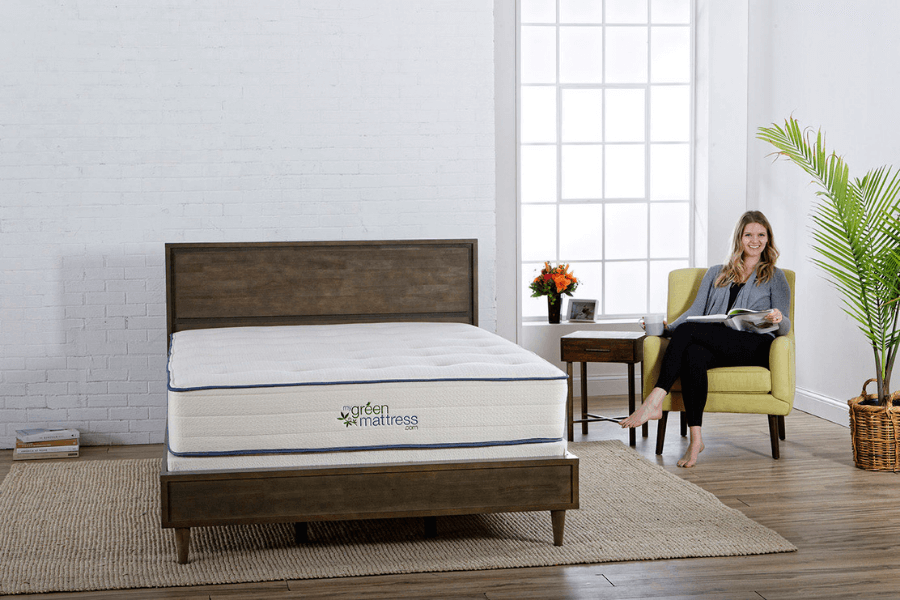
Born out of a father’s quest to help his daughter with eczema, My Green Mattress keeps sustainability personal. This family-owned company builds all its mattresses in their Illinois factory using GOTS-certified organic cotton, natural wool, and eco-INSTITUT-certified latex.
They handcraft each mattress to order, which means zero mass production and significantly less waste. Even their factory is powered by renewable energy, walking the talk from raw material to final stitch.
My Green Mattress offers full transparency in sourcing and certifications, plus budget-friendly prices that make organic sleep more accessible. The result? A grassroots brand that delivers big on eco-values without the corporate fluff.
Perfect for families and allergy-sensitive sleepers, My Green Mattress proves that personal care and planet care go hand in hand.
6. Eco Terra: Earth-Friendly, Coil-Backed Comfort
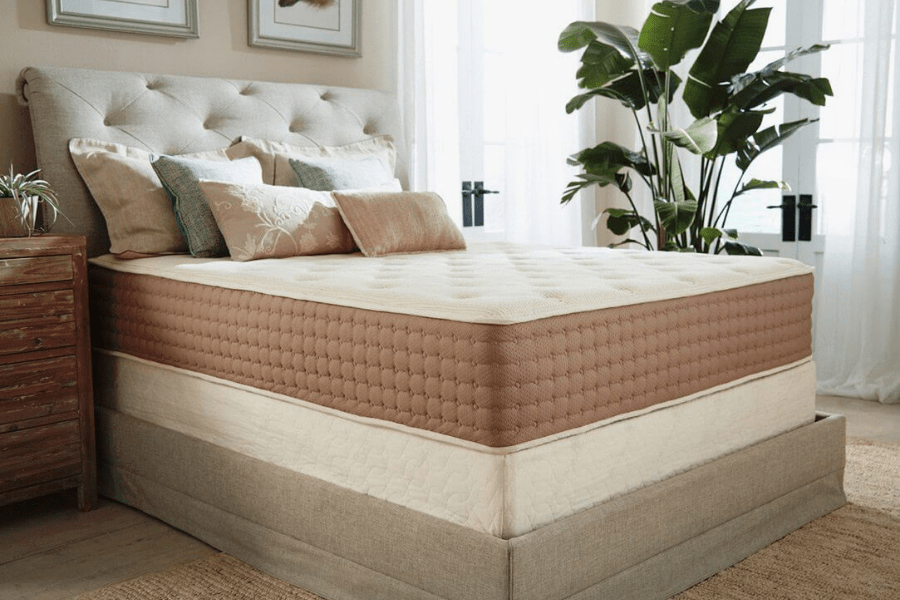
Eco Terra lives up to its name by crafting hybrid mattresses made entirely from sustainable materials — without synthetic foams, glues, or chemical fire retardants.
Handmade in California, each mattress features 100% natural latex from sustainable farms, wrapped in organic cotton and pure wool. What sets Eco Terra apart is its commitment to combining natural materials with individually wrapped coils — creating a greener hybrid that delivers ergonomic support and airflow.
They ship directly to customers, reducing environmental impact and offering fair pricing without retail markups. Plus, their packaging uses minimal plastics and recyclable materials.
For anyone seeking a mattress that balances body support with Earth stewardship, Eco Terra brings down-to-earth values to every night’s sleep.
7. Sleep On Latex: Pure Latex. Nothing More. Nothing Less.
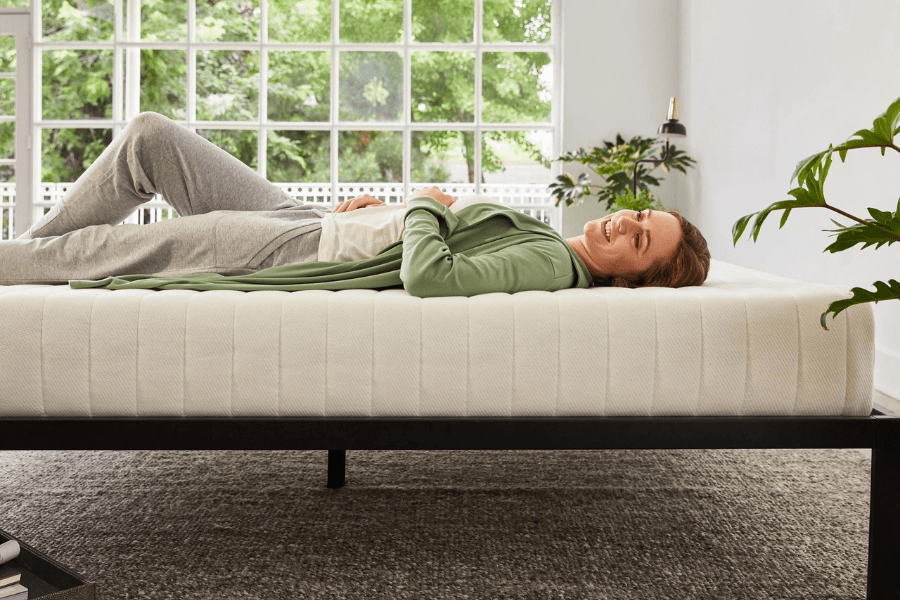
Sleep On Latex is exactly what it says — no gimmicks, no greenwashing. Just 100% natural latex foam, organic cotton, and natural wool, all assembled with minimal processing and maximum transparency.
Their flagship brand, Pure Green®, skips synthetic blends entirely, using sustainably tapped rubber tree sap to create a mattress that’s biodegradable, breathable, and built to last.
Manufactured in the U.S., Sleep On Latex emphasizes ethical labor and quality craftsmanship. Their eco-INSTITUT certification ensures products are free from harmful off-gassing chemicals, and their direct-to-consumer model keeps the carbon footprint lean.
If you’re looking for a straightforward, deeply sustainable latex mattress with zero fluff — this is the brand for you.
How to Choose the Best Organic Mattress?
Here’s everything you should know about why organic matters, such as why you should buy an organic crib mattress for your baby and where to buy an organic mattress.
What Is An Organic Mattress And Why Should You Choose One?
An organic mattress is a mattress made with naturally sourced materials without the use of harmful chemicals. Standard materials can contain heavy metals and chemical flame retardants. Materials used in organic mattresses are organic cotton, wool, and natural latex from rubber trees.
Organic mattresses, such as an organic cotton mattress, wool mattress, latex free mattress, have several advantages over standard materials.
Durability
Organic mattresses come with a steep price tag. But they’ll pay off because of their durability. A standard spring mattress will last 6 to 8 years before you notice wear and tear and loss of support.
However, organic mattresses last much longer. On average, an organic mattress can last between 15 to 20 years. That’s double the duration a standard mattress has.
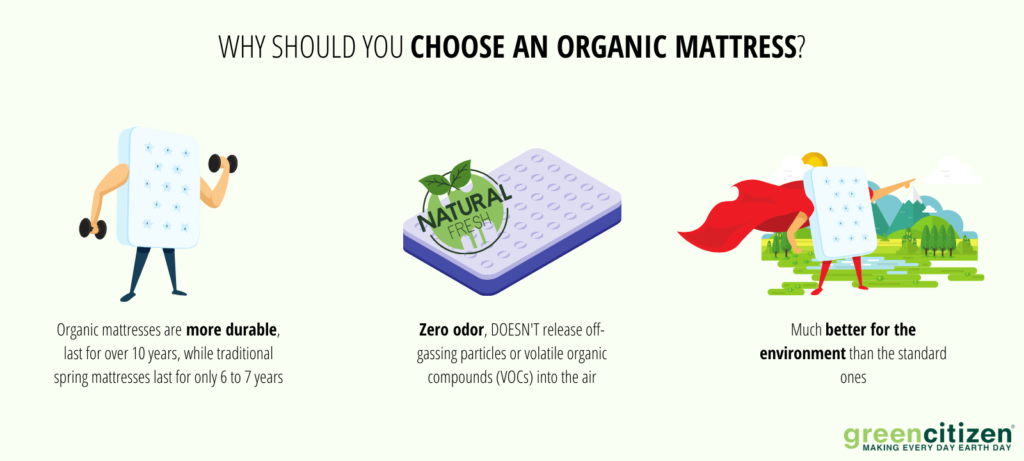
No Odor
When you unbox a standard mattress and settle it on your bed, it’ll release off-gassing particles or volatile organic compounds (VOCs) into the air. VOCs can cause several side effects, such as headaches, nausea, and of course, the unpleasant smell that lasts for a long time after you unpack the mattress.
Compared to a standard mattress, an organic mattress will have a short or none off-gassing period at all. This means when you open up the box and settle the mattress on the bed, there’ll be little or no odor at all.
This is because latex hybrid mattresses can have a smell at first. However, this smell is the natural smell of the material and isn’t harmful like VOC off-gassing is.
What’s more, latex and organic wool smell will last for more than a few days.
Note: Don’t let the word organic here confuse you. There’s nothing organic in VOCs, but it’s a purely synthetic material.
Environmentally-Friendly
Equally as important, organic mattresses are much better for the environment than the standard ones. Check the mattress certifications for natural and organic materials, ethical treatment of animals (for wool sourcing), and sustainable farming.
All of these reduce the mattress footprint. Moreover, organic mattresses can be more easily recycled.
Understanding the Organic Mattress Types
There are several organic mattress types you can choose from.
Latex
Latex comes from the sap of rubber trees. Latex mattresses are hypoallergenic, breathable, and resistant to mildew and dust mites. How latex is processed and if there are any chemicals used determines if it’ll be certified as organic or not.
Latex can be processed in two methods:
- Dunlop — The sap of the rubber tree is stirred, molded, and stem-baked. This latex is bottom-heavy and has a lighter substance on top. Because it’s firmer, it’s often used as a core for all latex mattresses.
- Talalay — The sap of the rubber tree is vacuum-sealed, frozen, then baked. It’s much lighter than Dunlop and is used in the comfort layer of latex mattresses.
Pro Tip: Be careful if you see a mattress that says it’s natural latex. There’s no official certification for natural latex, so always ask the seller for the composition. Some natural latex mattresses aren’t all that natural and can contain synthetic fillers.
Hybrid Mattresses
A hybrid mattress combines two or more mattress types. A hybrid mattress usually has a coil support core, and then there’s a latex comfort system.
Many hybrid mattresses have pocketed coils encased in fabric. These mattresses are more on the expensive side because they essentially combine two or more mattress types.
Pro Tip: Hybrid mattresses are made of various materials, so make sure to check the composition in detail to make sure it’s eco-friendly.
Innerspring Mattress
Innerspring is the traditional mattress. It has a support core made of coils. The standard mattress uses coils topped with a layer of padding, while organic mattress uses recycled steel coils encased in organic wool or cotton.
The innerspring mattress also has a comfort layer of foam. If the foam layer is more than two inches thick, the mattress is considered a hybrid.
Foam Mattress
While a foam mattress can never be 100% organic, you can find foam mattresses that are greener than others.
Foam mattresses are made of two materials:
- Standard polyurethane foam, i.e., polyfoam — Often found in support core layers and sometimes in comfort layers. Polyfoam isn’t treated with chemicals.
- Viscoelastic polyurethane foam, i.e., memory foam — Used in the comfort layer, and reacts to the sleeper’s body temperature and becomes softer. It’s been treated with petrochemicals.
Organic Mattress Certifications
There are several organic mattress certifications you should look for when shopping for a natural mattress:
- CertiPUR-US — Is one of the most rigorous tests (the only one that certifies that the mattress doesn’t contain polyurethane foam). It checks for mattress durability and emissions. A mattress with this certificate has no VOCs, chemical fire retardants, or heavy metals.
- Global Organic Latex Standard (GOLS) — Certifies that the latex is at least 95% organic.
- Global Organic Textile Standard (GOTS) — Certifies organic fibers. To get this certificate, a mattress has to use 70% organic fibers, and the other 30% can’t have any harmful chemicals, such as polyfoam.
- Oeko-Tex Standard 100 — Is made up of 18 research and testing institutes in Europe and Japan. It doesn’t certify that the mattress is organic, but it checks that it doesn’t exceed emission limits for chemicals, such as VOCs, flame restaurants, and dyes.
- Eco-Institut — Is a Germany-based institution that checks if textiles and building materials have harmful elements, such as chemicals, heavy metals, and hazardous emissions.
- United States Department of Agriculture (USDA) Organic Certification — This certification is mainly associated with food, but it’s also used to measure crops used to make materials.
- Rainforest Alliance Certified — This certification means that the material used to make the mattress was sourced from forests where sustainable harvesting is used, and endangered species are protected. Also, people working there are provided with living wages.
Frequently Asked Questions (FAQ)
Plushbeds – The Luxury Bliss is the best for side sleepers.
Yes, a memory foam mattress can be bad for your health. These mattresses contain heavy industrial chemicals which can irritate the eyes, nose, skin and lead to serious health problems, such as asthma.
Yes, your mattress could be making you sick. A mattress is loaded with hidden chemicals such as polyurethane which cause health issues. A mattress also sags over time, which leads to back and neck pain.
If you don’t change your mattress, you’ll suffer from various health issues, such as muscle stiffness, allergies, or asthma.
A standard mattress lasts between 6 to 10 years, while an organic mattress can last up to 20 years.
Choose Organic Mattress. Sleep Deeper. Tread Lighter.
Choosing an organic mattress isn’t just about better sleep — it’s a commitment to cleaner air, lower environmental impact, and a more ethical home. The brands we’ve covered here are leading that change, proving that comfort and conscience can go hand in hand.
But remember, the brand is just part of the story.
Our full buying guide gives you the tools to navigate certifications, understand materials, and ask the right questions before you buy. With the right info in hand, you can rest easy knowing your mattress supports more than just your back — it supports a better planet.
